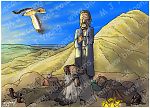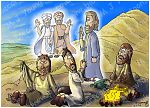Bible Cartoon: Luke 09 - The Transfiguration - Scene 03 - Jesus, Moses and Elijah
Click on Add to cart button below shopping cart.
Purchased Bible Cartoons do not have watermarks. Links to Cartoons provided on email once purchase is completed.Bible Book: Luke
Bible Book Code: 4200903001
Scene no: 3 of 6
Bible Reference & Cartoon Description
Luke 9:29b-31 (ANIV)
29 [As he was praying,] the appearance of his face changed, and his clothes became as bright as a flash of lightning. 30 Two men, Moses and Elijah, 31 appeared in glorious splendour, talking with Jesus. They spoke about his departure, which he was about to bring to fulfilment at Jerusalem.
DRAWING NOTES:
TIME OF DAY:
Just after sunrise.
LIGHTING NOTES:
I decided to set this whole story before, during & just after dawn. The light that comes from Jesus, Moses & Elijah in the transfiguration is mirrored by the light that occurs as the sun is rising over the earth. It’s as if God’s natural light (the sun) is part of the transfiguration & almost pays a natural homage to Jesus, the sun’s creator, before the light of the transfiguration takes over. Then, after the cloud has disappeared, we see the 3 disciples worhipping Jesus, once again the scene is bathed in the natural, worshipful glow of the sun’s own light.
Sunrise: natural sunlight & camp fire.
CHARACTERS PRESENT:
Scene 03 – Jesus, Moses & Elijah – Jesus, Moses, Elijah, Simon/Peter, James (son of Zebedee), John (son of Zebedee) & Snow Vole.
Notice the snow vole’s “Eeek!” of surprise at the sudden appearance of Moses & Elijah!
RESEARCH/ADDITIONAL NOTES:
Google earth position & orientation – 33 deg 26’ 46.81” N 35 deg 54’ 51.73” E looking NW, towards the sumit of mt. Hermon.
Israel is beyond that mountain. The viewer can see the Sea of Galillee approx. 42 miles away, & the Galilee region of Israel.
I deliberately set Jesus & the 3 disciples here, so that mt. Hermon was in the cartoon, with a view that includes the Sea of Galilee to help the viewer orient themselves.
My research led me to include a Snow Vole (Chionomys nivalis) in these cartoons. These small rodents are to be found on mt. Hermon.
Wikipedia: This vole is active by night as well as by day when it is quite easy to spot, especially on sunny days. It gets food from the roots of various alpine plants. It digs tunnels with numerous exits and a nest chamber as well as a kind of a storeroom. It does not hibernate in wintertime and often takes shelter in cellars, barns or haylofts to protect itself from the low temperatures. It holds its tail in an upright position when running.






